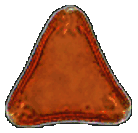

Butz Huryn, V.M. 1995: Use of native New Zealand plants by honey bees (Apis mellifera L.): a review. New Zealand journal of botany 33: 497-512.
Dallwitz, M.J., 1980: A general system for coding taxonomic descriptions. Taxon 29: 41-6.
Dallwitz, M.J.; Paine, T.A.; Zurcher, E.J., 1993 onwards: User's guide to the DELTA system: a general system for processing taxonomic descriptions. 4th edition. http://delta-intkey.com/
Dallwitz, M.J.; Paine, T.A.; Zurcher, E.J., 1999 onwards: User's guide to the DELTA Editor. http://delta-intkey.com/
Kirk, W. 2006: A colour guide to pollen loads of the honey bee. 2nd. ed. Cardiff (U.K.), International Bee Research Association.
Mabberley, D.J. 2008: Mabberley's plant book. 3rd ed. Cambridge (U.K.), Cambridge University Press.
Matheson, A.; Reid, M. 2011: Practical beekeeping in New Zealand. 4th ed. Auckland (N.Z.), Exisle Publishing Limited.
Mildenhall, D.C.; Tremain, R. 2005: Pollen analysis of New Zealand honey. Institute of Geological & Nuclear Sciences science report 2005/06. 19 p.
Moar, N.T. 1985: Pollen analysis of New Zealand honey. New Zealand journal of agricultural research 28: 39-70.
Punt, W.; Hoen, P.P.; Blackmore, S.; Nilsson, S.; Le Thomas, A. 2007: Glossary of pollen and spore terminology. Review of Palaeobotany and Palynology 143: 1–81.
Raine, I.; Li, X.; Newstrom-Lloyd, L. 2022: Pollen analysis for New Zealand beekeepers. Havelock North (N.Z.), The New Zealand Trees for Bees Research Trust. 98 p.
Sawyer, R. 1981: Pollen identification for beekeepers. Cardiff (U.K.), University College Press. [facsimile edition 2006 published by Northern Bee Books, Scout Bottom Farm, Mytholmroyd, Hebden Bridge, West Yorkshire]
Sawyer, R. 1988: Honey identification. Cardiff (U.K.), University College Press. [reprint 2010 published by Northern Bee Books, Scout Bottom Farm, Mytholmroyd, HX7 5JS, West Yorkshire]
Walsh, R.S. 1978: Nectar and pollen sources of New Zealand. Wellington, National Beekeepers Association of New Zealand. 59 p.
Winter, T.S. 1975: Beekeeping in New Zealand. Ministry of Agriculture and Fisheries bulletin 267: 155 p. Wellington (N.Z.), Government Printer.
APSA Members 2007: The Australasian Pollen and Spore Atlas V1.0. Australian National University, Canberra. https://apsa.anu.edu.au/
(Images from a very large collection of acetolysed pollen samples from Australian and Southeastern Asian plants, including New Zealand and Pacific Islands, accessed by taxonomic name or a simple morphological key).
D’Albore, G.R. 1997: Textbook of melissopalynology. Apimondia Publishing House, Bucharest, 308 p.
(Oriented towards Italy and the Mediterranean, but (like Sawyer 1988) contains illustrations of honey pollen from around the world.)
Large, M.F.; Braggins, J.E. 1991: Spore atlas of New Zealand ferns & fern allies. New Zealand journal of botany supplement. SIR Publishing, Wellington, 167 p.
(Comprehensive book illustrating acetolysed spores).
McIntyre, D.J. 1963: Pollen morphology of New Zealand species of Myrtaceae. Transactions of the Royal Society of New Zealand, botany 2: 83-107.
Medical University of Vienna. 2022: Pollen database.
https://www.polleninfo.org/en/aerobiology/pollen-atlas
(A beautifully illustrated database of unacetolysed pollen from over 90 species of the Tyrolean region, intended for allergy studies as well as for melissopalynology. Based on the book "Das Pollenbild der Südtiroler Honige" by E. Bucher, V. Kofler, G. Vorwohl, and E. Zieger (2004), published by the Biological Laboratory of the State Agency for the Environment, Austria).
Moar, N.T. 1993: Pollen Grains of New Zealand Dicotyledonous Plants. Manaaki Whenua Press, Lincoln, N.Z. 200 p.
(Comprehensive book illustrating and describing acetolysed pollen, with key to identification. In 2022 unfortunately out of print but probably obtainable second-hand).
Persano Oddo L., Piro R. 2004: Main European unifloral honeys: descriptive sheets. Apidologie 35 (Suppl. 1): S38–S81.
(Illustrates the key pollen types of the honeys, with other data).
Pocknall, D.T. 1981a: Pollen morphology of the New Zealand species of Dacrydium Solander, Podocarpus L'Heritier, and Dacrycarpus Endlicher (Podocarpaceae). New Zealand journal of botany 19: 67-95.
Pocknall, D.T. 1981b: Pollen morphology of the New Zealand species of Libocedrus Endlicher (Cupressaceae) and Agathis Salisbury (Araucariacaeae). New Zealand journal of botany 19: 267-272.
Pocknall, D.T. 1981c: Pollen morphology of Phyllocladus L.C. et A. Rich. New Zealand journal of botany 19: 259-266.
(The three publications by Pocknall cover the pollen of all of the New Zealand native conifers).
Trigg, H., S. Jacobucci, M. Henkel, and J. Steinberg. 2013. Human Impacts Pollen Database, an Illustrated Key. Andrew Fiske Center for Archaeological Research, University of Massachusetts Boston.
https://www.fiskecenter.umb.edu/Research/Pollen_Database.html
(A Lucid-based key to acetolysed pollen of over 800 taxa, with focus on North America and study of archaeological sites)
Cite this publication as:
"J.I. Raine, X. Li, L. Newstrom-Lloyd (2022).
New Zealand bee pollen database.
"
© GNS Science, 2022